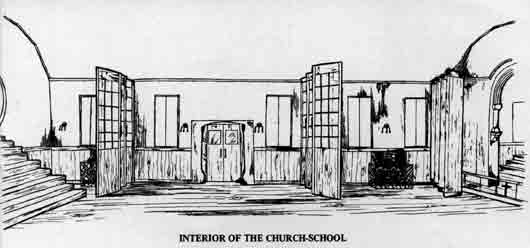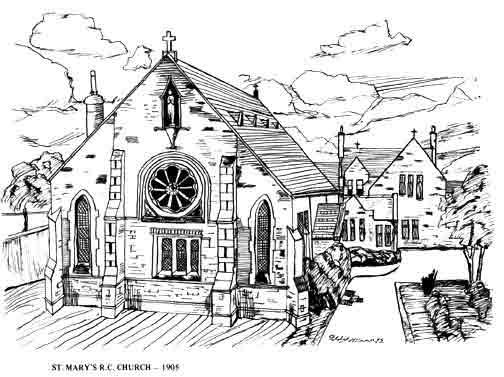
His successor, Father Ambrose Graham, continued his attempts. He was successful. He not only built a brand new school but made it in such a way that it was also a brand new church! As many of our senior parishioners remember from their schooldays, it was the building which is still our present church. The 1884 Directory contained the following description of its opening:
'A new Chapel-School was solemnly opened here on 10 June, 1883, the feast of St. Margaret. It is pleasantly situated in West Back Road, in a field acquired some time ago by the pastor of the congregation, in order to further the movement recently set on foot by the bishop of Galloway to provide adequately for the spiritual and educational wants of the Catholics of North Ayrshire. The style of architecture is early English and the interior is partitioned off so that it can be utilised as a day school.
One portion is designed to serve as an infants' classroom, suited for seventy-six pupils, the other as a mixed school, accommodating two hundred and fifty. As a Church, the building was intended to seat four hundred, but by throwing in the classrooms the accommodation will be almost doubled. The seats are in the form of folding desks, and serve both as seats for the Church and as writing desks for the children. Separate entrances are provided for the Church and school.
The presbytery is a substantially built two-storey house, connected with the vestry by a corridor. In a niche in the facade of the Church has been placed a well-finished statuette of Our Lady, venerated in Catholic days as the special Patroness of the Church and Burgh of Irvine. Messrs. Ingram, Kilmarnock designed the buildings, of which the Marquess of Bute defrayed about half of the entire cost.
The opening services, presided over by the Bishop were attended by large congregations. Father O'Reilly, SJ Glasgow, preached in the morning, and the Rev. Dr. Toner, Newcastleon-Tyne, in the evening. The music was admirably rendered by the choir of St. Margaret's, Ayr. On the next day, 11 June, the school was opened in the presence of the Bishop, and 170 children were enrolled under the charge of two certificated teachers'.
This new building was 100 feet long and 34 feet across. There were two-side entrances, where the confessionals are now, that on the right being the entrance to the church and that on the left the entrance to the school. The east gable wall, where the entrance is now, had three oblong windows in it. The sanctuary at the west end was partitioned off by a curtain. In each section there was an open fireplace. The whole building was lit by gas, from triform jets along the side-walls, including the walls of the sanctuary. The schooldesks were placed lengthwise down the building during the week and on Fridays the older boys had to turn them round across the building so that they faced the sanctuary Thus they became seats for Sunday morning. After Benediction on Sunday evening they were replaced ready for school on Monday.

EXTERIOR

In the meantime, in 1897, Father Frederick Letters had become parish priest. He stayed here until 1911. From 1902 he also, as the manager of the school, had the worry of trying to maintain a permanent staff and in addition the Inspectors were beginning to find fault with the buildings: - '…the premises are not at all well adapted for school purposes. It would be a great advantage educationally if the managers could see their way to provide a more suitable building'. (Inspectors' Report, August 1905). The managers could not any more than they could see a way to providing teachers. Between 1902 and 1906 there were five different headteachers and frequent changes amongst the assistants, and by 1905 the roll was one hundred and eighty.